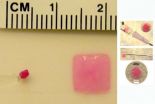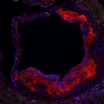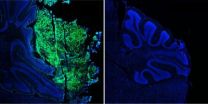(Press-News.org) (SACRAMENTO, Calif.) — In a sobering study published in the journal Environmental Health, researchers at UC Davis and UCLA measured food-borne toxin exposure in children and adults by pinpointing foods with high levels of toxic compounds and determining how much of these foods were consumed. The researchers found that family members in the study, and preschool children in particular, are at high risk for exposure to arsenic, dieldrin, DDE (a DDT metabolite), dioxins and acrylamide. These compounds have been linked to cancer, developmental disabilities, birth defects and other conditions. However, the study also points to dietary modifications that could mitigate risk.
"Contaminants get into our food in a variety of ways," said study principal investigator Irva Hertz-Picciotto, professor and chief of the Division of Environmental and Occupational Health at UC Davis. "They can be chemicals that have nothing to do with the food or byproducts from processing. We wanted to understand the dietary pathway pesticides, metals and other toxins take to get into the body."
Researchers assessed risk by comparing toxin consumption to established benchmarks for cancer risk and non-cancer health risks. All 364 children in the study (207 preschool children between two and seven and 157 school-age children between five and seven) exceeded cancer benchmarks for arsenic, dieldrin, DDE and dioxins. In addition, more than 95 percent of preschool children exceeded non-cancer risk levels for acrylamide, a cooking byproduct often found in processed foods like potato and tortilla chips. Pesticide exposure was particularly high in tomatoes, peaches, apples, peppers, grapes, lettuce, broccoli, strawberries, spinach, dairy, pears, green beans and celery.
"We focused on children because early exposure can have long-term effects on disease outcomes," said Rainbow Vogt, lead author of the study. "Currently, the U.S. Environmental Protection Agency only measures risk based on exposures of individual contaminants. We wanted to understand the cumulative risk from dietary contaminants. The results of this study demonstrate a need to prevent exposure to multiple toxins in young children to lower their cancer risk."
The researchers used data from the 2007 Study of Use of Products and Exposure-Related Behavior (SUPERB), which surveyed households in California with children between two and five to determine how their diets, and other factors, contribute to toxic exposure. Specifically, SUPERB homed in on 44 foods known to have high concentrations of toxic compounds: metals, arsenic, lead and mercury; pesticides chlorpyrifos, permethrin and endosulfan; persistent organic pollutants dioxin, DDT, dieldrin and chlordane; and the food processing byproduct acrylamide. Toxin levels in specific foods were determined through the Total Diet Study and other databases.
Perhaps most disturbing, preschool-age children had higher exposure to more than half the toxic compounds being measured. Even relatively low exposures can greatly increase the risk of cancer or neurological impairment.
"We need to be especially careful about children, because they tend to be more vulnerable to many of these chemicals and their effects on the developing brain," says Hertz-Picciotto.
Though these results are cause for concern, the study also outlines strategies to lower family exposure. For example, organic produce has lower pesticide levels. In addition, toxin types vary in different foods. Certain pesticides may be found in lettuce and broccoli, while others affect peaches and apples.
"Varying our diet and our children's diet could help reduce exposure," said Hertz-Picciotto. "Because different foods are treated differently at the source, dietary variation can help protect us from accumulating too much of any one toxin."
Families also can reduce their consumption of animal meat and fats, which may contain high levels of DDE and other persistent organic pollutants, and switch to organic milk. While mercury is most often found in fish, accumulation varies greatly by species. Smaller fish, lower on the food chain, generally have lower mercury levels. In addition, acrilomides are relatively easy to remove from the diet.
"Acrilomides come from chips and other processed grains, said co-author Deborah Bennett, associate professor of Environmental and Occupational Health at UC Davis. "Even if we set aside the potential toxins in these foods, we probably shouldn't be eating large amounts of them anyway. However, we should be eating fruits, vegetables and fish, which are generally healthy foods. We just need to be more careful in how we approach them."
The study also highlights a number of policy issues, such as how we grow our food and the approval process for potentially toxic compounds. Though the pesticide DDT was banned 40 years ago, the study showed significant risk of DDE exposure.
"Given the significant exposure to legacy pollutants, society should be concerned about the persistence of compounds we are currently introducing into the environment," said Bennett. "If we later discover a chemical has significant health risks, it will be decades before it's completely removed from the ecosystem."
While the study has profound implications for dietary habits, more work needs to be done to quantify risk. Specifically, researchers need to determine how these food-borne toxins interact collectively in the body.
### This research was funded by a Science to Achieve Results (STAR) grant #RD-83154001 from the United States Environmental Protection Agency.
Other authors include Diana Cassady and Joshua Frost at the UC Davis Department of Public Health Sciences and Beate Ritz at the UCLA Department of Epidemiology.
The UC Davis School of Medicine is among the nation's leading medical schools, recognized for its research and primary-care programs. The school offers fully accredited master's degree programs in public health and in informatics, and its combined M.D.-Ph.D. program is training the next generation of physician-scientists to conduct high-impact research and translate discoveries into better clinical care. Along with being a recognized leader in medical research, the school is committed to serving underserved communities and advancing rural health. For more information, visit UC Davis School of Medicine at medschool.ucdavis.edu.
Study finds high exposure to food-borne toxins
Preschool children are particularly vulnerable to compounds linked to cancer and other conditions
2012-11-14
ELSE PRESS RELEASES FROM THIS DATE:
Fantasy-reality confusion a primary cause of childhood nighttime fears
2012-11-14
From monsters under the bed to bogeymen in the closet, most children experience nighttime fears at some point in their development. And while most grow out of them without any professional intervention, others contend with persistent and extended periods of these fears, with a risk of developing anxiety problems later in life.
As part of a large-scale project on nighttime fears funded by the Israeli Science Foundation, Prof. Avi Sadeh of Tel Aviv University's School of Psychological Sciences is exploring how these fears fit into the normal developmental process — and ...
Injectable sponge delivers drugs, cells, and structure
2012-11-14
Cambridge, Mass. – November 13, 2012 – Bioengineers at Harvard have developed a gel-based sponge that can be molded to any shape, loaded with drugs or stem cells, compressed to a fraction of its size, and delivered via injection. Once inside the body, it pops back to its original shape and gradually releases its cargo, before safely degrading.
The biocompatible technology, revealed this week in the Proceedings of the National Academy of Sciences, amounts to a prefabricated healing kit for a range of minimally invasive therapeutic applications, including regenerative medicine.
"What ...
Targeting downstream proteins in cancer-causing pathway shows promise in cell, animal model
2012-11-14
PHILADELPHIA - The cancer-causing form of the gene Myc alters the metabolism of mitochondria, the cell's powerhouse, making it dependent on the amino acid glutamine for survival. In fact, 40 percent of all "hard-to-treat" cancers have a mutation in the Myc gene.
Accordingly, depriving cells of glutamine selectively induces programmed cell death in cells overexpressing mutant Myc.
Using Myc-active neuroblastoma cancer cells, a team led by Howard Hughes Medical Institute (HHMI) investigator M. Celeste Simon, Ph.D., scientific director for the Abramson Family Cancer ...
Vitamin D may prevent clogged arteries in diabetics
2012-11-14
People with diabetes often develop clogged arteries that cause heart disease, and new research at Washington University School of Medicine in St. Louis suggests that low vitamin D levels are to blame.
In a study published Nov. 9 in the Journal of Biological Chemistry, the researchers report that blood vessels are less like to clog in people with diabetes who get adequate vitamin D. But in patients with insufficient vitamin D, immune cells bind to blood vessels near the heart, then trap cholesterol to block those blood vessels.
"About 26 million Americans now have type ...
Being neurotic, and conscientious, a good combo for health
2012-11-14
Under certain circumstances neuroticism can be good for your health, according to a University of Rochester Medical Center study showing that some self-described neurotics also tended to have the lowest levels of Interleukin 6 (IL-6), a biomarker for inflammation and chronic disease.
Researchers made the preliminary discovery while conducting research into how psychosocial factors such as personality traits influence underlying biology, to predict harmful conditions like inflammation.
Known as one of the "Big 5" traits, neuroticism is usually marked by being moody, nervous, ...
Research strengthens link between obesity and dental health in homeless children
2012-11-14
Obesity and dental cavities increase and become epidemic as children living below the poverty level age, according to nurse researchers from the Case Western Reserve University and the University of Akron.
"It's the leading cause of chronic infections in children," said Marguerite DiMarco, associate professor at the Frances Payne Bolton School of Nursing at Case Western Reserve University.
Researchers Sheau-Huey Chiu, assistant professor, and graduate assistant Jessica L. Prokp, from the University of Akron's College of Nursing, contributed to the study.
Researchers ...
For brain tumors, origins matter
2012-11-14
Cancers arise when a normal cell acquires a mutation in a gene that regulates cellular growth or survival. But the particular cell this mutation happens in—the cell of origin—can have an enormous impact on the behavior of the tumor, and on the strategies used to treat it.
Robert Wechsler-Reya, Ph.D., professor and program director at Sanford-Burnham Medical Research Institute, and his team study medulloblastoma, the most common malignant brain cancer in children. A few years ago, they made an important discovery: medulloblastoma can originate from one of two cell types: ...
Stem cell finding could advance immunotherapy for lung cancer
2012-11-14
CINCINNATI—A University of Cincinnati (UC) Cancer Institute lung cancer research team reports that lung cancer stem cells can be isolated—and then grown—in a preclinical model, offering a new avenue for investigating immunotherapy treatment options that specifically target stem cells.
John C. Morris, MD, and his colleagues report their findings in the Nov. 13, 2012, issue of PLOS One, a peer-reviewed online publication that features original research from all disciplines within science and medicine.
Stem cells are unique cells that can divide and differentiate into ...
New type of bacterial protection found within cells
2012-11-14
Irvine, Calif., Nov. 13, 2012 — UC Irvine biologists have discovered that fats within cells store a class of proteins with potent antibacterial activity, revealing a previously unknown type of immune system response that targets and kills bacterial infections.
Steven Gross, UCI professor of developmental & cell biology, and colleagues identified this novel intercellular role of histone proteins in fruit flies, and it could herald a new approach to fighting bacterial growth within cells. The study appears today in eLife, a new peer-reviewed, open-access journal supported ...
Uranium exposure linked to increased lupus rate
2012-11-14
CINCINNATI—People living near a former uranium ore processing facility in Ohio are experiencing a higher than average rate of lupus, according a new study conducted by scientists at the University of Cincinnati and Cincinnati Children's Hospital Medical Center.
Lupus is a chronic inflammatory disease that can affect the skin, joints, kidneys, lungs, nervous system and other organs of the body. The underlying causes of lupus are unknown, but it is usually more common in women of child-bearing age.
For this new study, a collaborative team of UC and Cincinnati Children's ...
LAST 30 PRESS RELEASES:
COVID-19 leaves a lasting mark on the human brain
Scientists use ultrasound to soften and treat cancer tumors without damaging healthy tissue
Community swimming program for Black youth boosts skills, sense of belonging, study finds
Specific depressive symptoms in midlife linked to increased dementia risk
An ‘illuminating’ design sheds light on cholesterol
Who is more likely to get long COVID?
Study showcases resilience and rapid growth of “living rocks”
Naval Research Lab diver earns Office of Naval Research 2025 Sailor of the Year
New Mayo-led study establishes practical definition for rapidly progressive dementia
Fossil fuel industry’s “climate false solutions” reinforce its power and aggravate environmental injustice
Researchers reveal bias in a widely used measure of algorithm performance
Alcohol causes cancer. A study from IOCB Prague confirms damage to DNA and shows how cells defend against it
Hidden viruses in wastewater treatment may shape public health risks, study finds
Unlock the power of nature: how biomass can transform climate mitigation
Biochar reshapes hidden soil microbes that capture carbon dioxide in farmland
Reducing saturated fat intake shows mortality benefit, but only in high-risk individuals
Manta rays create mobile ecosystems, study finds
Study: Mixed results in using lipoic acid to treat progressive multiple sclerosis
Norbert Holtkamp appointed director of Fermi National Accelerator Laboratory
New agentic AI platform accelerates advanced optics design
Biologists discover neurons use physical signals — not electricity — to stabilize communication
Researchers discover that a hormone can access the brain by hitchhiking
University of Oklahoma researcher awarded funding to pursue AI-powered material design
Exploring how the visual system recovers following injury
Support for parents with infants at pediatric check-ups leads to better reading and math skills in elementary school
Kids’ behavioral health is a growing share of family health costs
Day & night: Cancer disrupts the brain’s natural rhythm
COVID-19 vaccination significantly reduces risk to pregnant women and baby
The role of vaccination in maternal and perinatal outcomes associated with COVID-19 in pregnancy
Mayo Clinic smartwatch system helps parents shorten and defuse children's severe tantrums early
[Press-News.org] Study finds high exposure to food-borne toxinsPreschool children are particularly vulnerable to compounds linked to cancer and other conditions



